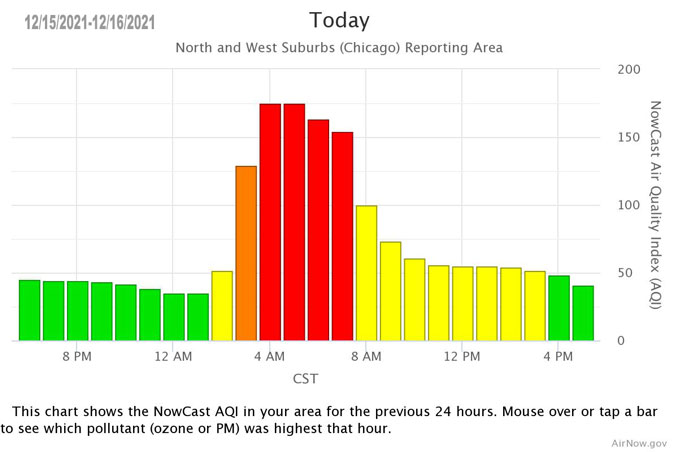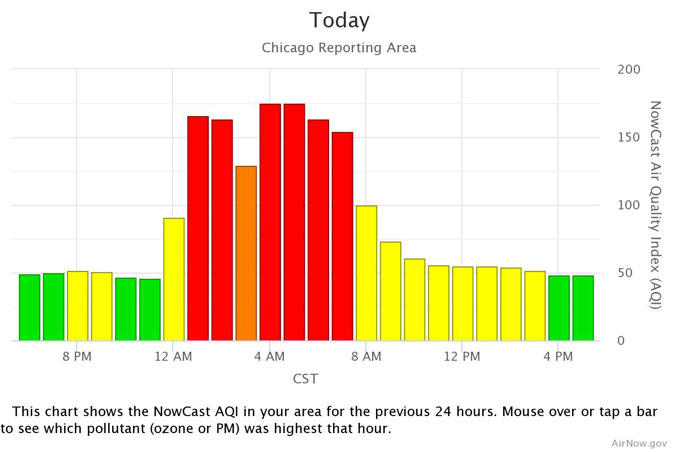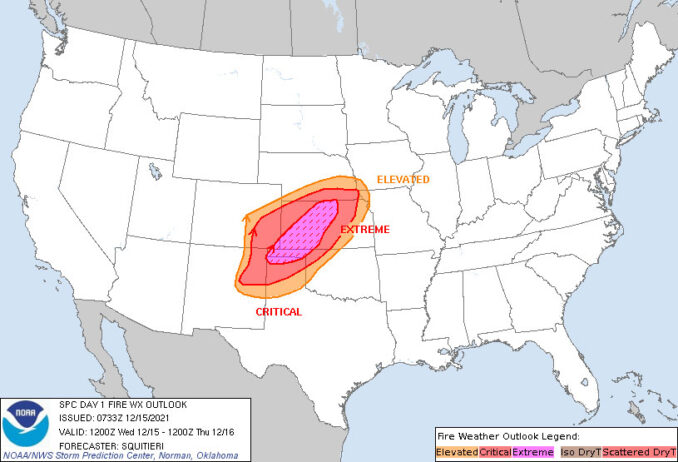Smoke from Kansas, Oklahoma, and Texas panhandle wildfires may have caused residents of Chicagoland to smell smoke from these wildfires.
Wildfires fueled by high wind destroy homes in Kansas YouTube Tips ⓘ
The odor of smoke and the sight of hazy skies alarmed several people overnight Wednesday/Thursday — enough to call 9-1-1 and ask the fire department to come out and investigate.
Beginning about 2:30 a.m. Thursday, December 16, 2021 firefighters from Arlington Heights, Bannockburn, Buffalo Grove, Des Plaines, Elk Grove Village, Highland Park, Lake Forest, North Main Fire Protection District in Des Plaines, Palatine, Park Ridge, Schaumburg, Vernon Hills, and Wheeling responded to 9-1-1 calls reporting smoke or smoke odor. A North Maine FPD fire crew reported the Moon had an orangish color and speculated smoke was from somewhere else.
The NWS Chicago office tweeted an alert at 3:59 AM CST that, “early risers out there may smell smoke. Have no fear – there are no fires nearby. The smoke is actually from Kansas, traveling some 600 miles overnight with the strong southwest winds.”
Wildfires had also been reported in Oklahoma and the Texas panhandle.
The NWS Chicago office also tweeted, “There are some big fires out there … Winds gusted 80 to 100 mph yesterday afternoon rapidly spread brush fires. Many of the fires continue at this hour.”
When AQI values are above 100, air quality is unhealthy: at first for certain sensitive groups of people, then for everyone as AQI values get higher.
The Air Quality Index (AQI) measurement from AirNow.gov spiked early Thursday, December 16, 2021 beginning about 2:00 a.m. and peaked from 4:00 a.m. to 5:00 a.m., reaching 175. EPA establishes an AQI for five major air pollutants regulated by the Clean Air Act. Each of these pollutants has a national air quality standard set by EPA to protect public health. The factors in the AQI include ground-level ozone, particle pollution (also known as particulate matter, including PM2.5 and PM10), carbon monoxide, sulfur dioxide, and nitrogen dioxide. Some areas of Chicagoland were above AQI 151 for four hours. The City of Chicago was above 150 for six hours.
The predominant pollutant was PM2.5, which are tiny particles or droplets in the air that are two and one half microns or less in width. According to a study published in Respirology in December 2021, the researchers concluded that long-term PM2.5 exposure is associated with increased hospitalization in COVID-19.


An AQI value over 300 represents hazardous air quality and below 50 the air quality is good. According to AirNow.gov, for each pollutant, an AQI value of 100 generally corresponds to an ambient air concentration that equals the level of the short-term national ambient air quality standard for protection of public health. AQI values at or below 100 are generally thought of as satisfactory. At levels between 151 and 200, some members of the general public may experience health effects; members of sensitive groups may experience more serious health effects.
Meanwhile regarding the Kansas situation contributing to Chicagoland’s smokey conditions and poor air quality, the Day 1 Fire Weather Outlook from the NWS Storm Prediction Center that was posted 0133 AM CST Wednesday, Dec 15 2021 stated …
“Very dangerous wildfire-spread conditions are still expected for portions of the central Plains today. A 110 kt mid-level jet streak accompanying a potent mid-level shortwave trough will traverse the central Plains as an intense surface low quickly ejects into the Upper Mississippi Valley this afternoon. An impressive vertical wind profile will accompany the passing low, with widespread 60+ kt low-level flow (just a few hundred feet above the ground) coinciding with a mixing boundary layer. Gradient surface flow associated with this intense low, combined with vertical mixing, will support very windy and dry conditions atop critically dry fuels (90-98th percentile Energy Release Component or ERCs) to support very rapid grassfire spread.
From late morning into mid afternoon, a few hours of widespread 35+ mph sustained west-southwesterly surface winds will overlap with 10-15 percent Relative Humidity. Extremely Critical fire weather highlights remain in place where confidence is highest in very windy/dry conditions persisting longer than 3 hours, and where patchy areas of 40+ mph sustained winds are more likely. East of the Extremely Critical delineation, high-end Critical to locally Extremely Critical conditions are likely.”

The wildfire warnings included southeast Colorado, northeast New Mexico, the Texas panhandle, most of Kansas, and southeast Nebraska preceded actual wildfires that erupted Wednesday in Kansas, Oklahoma and Texas. Several homes were destroyed in Russell County, Kansas.
Rare chance to get drone video of a wildfire. No TFR yesterday due to winds being too high for aircraft support. This was near Guymon, Ok. #wildfire #kswx #wind #WX pic.twitter.com/G0qyS4L26J
— WxChasing- Brandon Clement (@bclemms) December 16, 2021
JUST IN: A viewer just sent in this video of a grass fire along Interstate 435 and Parallel Parkway in Kansas City, Kansas. pic.twitter.com/eY4UjnNJxw
— KSHB 41 News (@KSHB41) December 16, 2021
Winds reaching as high as 100 miles per hour generated wildfires and dust storms across parts of Kansas, the authorities said. https://t.co/f32Yz2fUhu
— The New York Times (@nytimes) December 16, 2021
One of numerous homes burned in Russell county #Kansas. This one in the town of #Paradise. Many #wildfires are still burning. pic.twitter.com/iis6Qe6Gz1
— WxChasing- Brandon Clement (@bclemms) December 16, 2021
The smoke was not immediately dissipated while 50 to 60 MPH gusts affected Chicagoland during a High Wind Warning. After the AIQ peaked, and after sunrise, the AIQ levels remained slightly elevated on Thursday compared to Wednesday. Remote Illinois communities, such as Galena, Peoria and Champaign also experienced elevated AIQ, but with different hourly patterns and different levels.
Contributing to smokey conditions in Chicagoland was an extra alarm fire about 12:45 a.m. Thursday, December 16, 2021 in Schiller Park, located at 4328 United Parkway, just southeast of O’Hare International Airport.
^^ MOBILE? USE VOICE MIC ^^
facebook …
Please ‘LIKE’ the ‘Arlington Cardinal Page. See all of The Cardinal Facebook fan pages at Arlingtoncardinal.com/about/facebook …
Help fund The Cardinal Arlingtoncardinal.com/sponsor
20240105-1435future
THANKS FOR READING CARDINAL NEWS
Along with the winds today come very dry conditions behind the dry line. Very low RH values in concert with the wind and cured fuels lead to Dangerous Fire Weather Conditions today along and northwest of the I-35 corridor. #kswx pic.twitter.com/c8lJ2htULh
— NWS Topeka (@NWSTopeka) December 15, 2021
Very strong winds crank up across the area this morning into this afternoon. Secure any remaining outdoor Christmas decorations and try not to travel unless it is an emergency. Be prepared for some gusts to reach 70mph or possibly higher at times today! #kswx pic.twitter.com/YfTdWh2Rsk
— NWS Topeka (@NWSTopeka) December 15, 2021
Extremely critical #fire #weather conditions are expected tomorrow afternoon as winds increase to 30-45 mph with very low relative humidity from the high plains of NM and CO into central KS and southern NE. (1/3) pic.twitter.com/SaYFrgraVN
— NWS Storm Prediction Center (@NWSSPC) December 14, 2021
See also …
Mendy A, Wu X, Keller JL, Fassler CS, Apewokin S, Mersha TB, Xie C, Pinney SM. Air pollution and the pandemic: Long-term PM2.5 exposure and disease severity in COVID-19 patients. Respirology. 2021 Dec;26(12):1181-1187. doi: 10.1111/resp.14140. Epub 2021 Aug 30. PMID: 34459069; PMCID: PMC8662216.
